NCBS Intern Report by: Kimberly Magee, Intern with UF IFAS Nature Coast Biological Station and Dr. Savanna Barry
The Dynamic Intern Duo
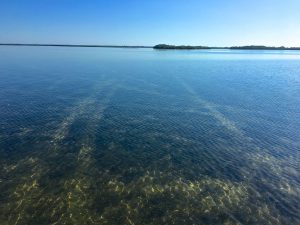
Many people who have worked with the public probably have a pretty bleak opinion of people. However, they probably didn’t have the same experience I did this summer. This summer I had the opportunity to intern with the UF/IFAS Nature Coast Biological Station on a human dimensions project concerning recreational boating and scalloping under Dr. Savanna Barry.
The project was to collect roughly 300 surveys about 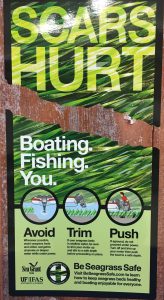 seagrass scarring and boating at three boat ramps along the Nature Coast: Steinhatchee, Crystal River, and Cedar Key. It sounds overwhelming, but Dr. Barry, in her infinite wisdom, had two interns this summer, my coworker the incredible Alec Cronin and me. We became a dynamic duo, tackling our task with me bringing an incredible amount of optimism and enthusiasm about how many surveys we would get each day and Alec keeping my toes to the ground so I wouldn’t get too disappointed by the slow progress. The goal for this project was to use the data from the surveys we gathered to create more effective public boater education campaigns about the importance of seagrass beds and the adverse effects of scarring. In short, we want to affect how boaters behave on the water by informing them of these issues and how they can help conserve important habitat.
seagrass scarring and boating at three boat ramps along the Nature Coast: Steinhatchee, Crystal River, and Cedar Key. It sounds overwhelming, but Dr. Barry, in her infinite wisdom, had two interns this summer, my coworker the incredible Alec Cronin and me. We became a dynamic duo, tackling our task with me bringing an incredible amount of optimism and enthusiasm about how many surveys we would get each day and Alec keeping my toes to the ground so I wouldn’t get too disappointed by the slow progress. The goal for this project was to use the data from the surveys we gathered to create more effective public boater education campaigns about the importance of seagrass beds and the adverse effects of scarring. In short, we want to affect how boaters behave on the water by informing them of these issues and how they can help conserve important habitat.
A Relief from the Heat
When we weren’t sweating at boat ramps in the blistering Florida sun surveying boaters as they 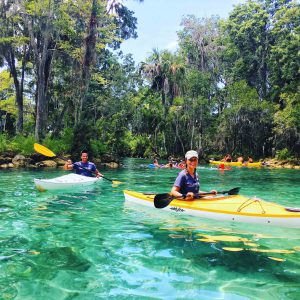 prepared for a day of scalloping, Alec and I were kayaking in the beautiful King’s Bay on Crystal River. Aside from the seagrass surveys, we also needed to collect 90 kayak surveys regarding scallop shucking in Citrus County because shell dumping is a growing problem the county is trying to change. Those days by far were my favorite days. We’d paddle up to boats anchored in the shallows around the Crystal River National Wildlife Refuge, over by King Spring and in front of Three Sisters Springs. Our clientele were much happier to speak with us, making the conversations more interesting and amusing.
prepared for a day of scalloping, Alec and I were kayaking in the beautiful King’s Bay on Crystal River. Aside from the seagrass surveys, we also needed to collect 90 kayak surveys regarding scallop shucking in Citrus County because shell dumping is a growing problem the county is trying to change. Those days by far were my favorite days. We’d paddle up to boats anchored in the shallows around the Crystal River National Wildlife Refuge, over by King Spring and in front of Three Sisters Springs. Our clientele were much happier to speak with us, making the conversations more interesting and amusing.
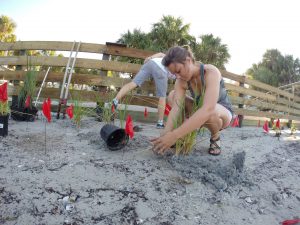 This summer has been a huge learning experience for me. I have a profound respect for the groundwork that goes into developing education campaigns that make science more available to the public. I came into this internship not even having heard of seagrass scarring and now I understand its importance and the threat it poses to the habitat. I was encouraged by how environmentally conscious and enthusiastic many people were about the issue and how receptive they were to our message.
This summer has been a huge learning experience for me. I have a profound respect for the groundwork that goes into developing education campaigns that make science more available to the public. I came into this internship not even having heard of seagrass scarring and now I understand its importance and the threat it poses to the habitat. I was encouraged by how environmentally conscious and enthusiastic many people were about the issue and how receptive they were to our message.
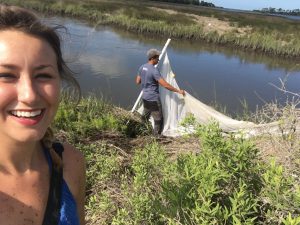 This internship was an adventure in more ways than one because we also had the opportunity to work hands-on and hip deep in mud with a couple other projects on our off days. I gained technical experience seine netting for snook with Emma Pistole for her graduate research on the population genetics of snook and I gained perspective on the great amount of effort that goes into restoring a living shoreline at Joe Raines Beach in Cedar Key with Dr. Mark Clark.
This internship was an adventure in more ways than one because we also had the opportunity to work hands-on and hip deep in mud with a couple other projects on our off days. I gained technical experience seine netting for snook with Emma Pistole for her graduate research on the population genetics of snook and I gained perspective on the great amount of effort that goes into restoring a living shoreline at Joe Raines Beach in Cedar Key with Dr. Mark Clark.
 0
0

Comments are closed.